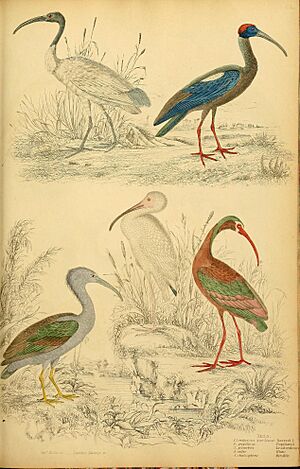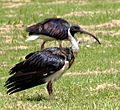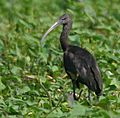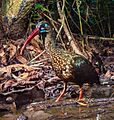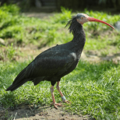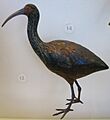Ibis facts for kids
Quick facts for kids Ibis |
|
|---|---|
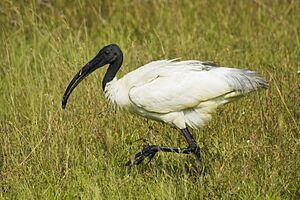 |
|
| Black-headed ibis (Threskiornis melanocephalus) | |
| Scientific classification |
|
| Kingdom: | Animalia |
| Phylum: | Chordata |
| Class: | Aves |
| Order: | Pelecaniformes |
| Family: | Threskiornithidae |
| Subfamily: | Threskiornithinae Poche, 1904 |
| Type genus | |
| Threskiornis G.R. Gray, 1842
|
|
| Genera | |
|
|
The ibis is a type of long-legged bird that lives near water. You can find them in wetlands, forests, and open plains. The word "ibis" comes from ancient Latin and Greek words for these birds.
Contents
What are Ibises Like?
Ibises have long, curved beaks that point downwards. They often feed in groups, using their beaks to search for food in the mud. They mostly eat small creatures like crustaceans (think crabs or shrimp).
Ibises are known for being loyal partners. They usually have one mate for life. They are also very protective of their nesting areas and where they find food. Most ibises build their nests in trees. They often share these nesting spots with other birds like spoonbills or herons.
Most ibis species today can fly. However, two types of ibises that are now extinct could not fly. One was the Apteribis from the Hawaiian Islands, which was a bit like a kiwi bird. The other was the unusual Xenicibis from Jamaica. The word ibis comes from the ancient Egyptian word hb or hīb.
Types of Ibises
There are many different kinds of ibises in the world. Scientists have found 29 types that are still alive today. There are also 4 types that are now extinct. Some of the most well-known types include:
- The African sacred ibis
- The Australian white ibis
- The Scarlet ibis
- The Northern bald ibis
- The Hadada ibis
Some extinct ibis species include the Jamaican ibis, also called the clubbed-wing ibis. This bird was special because its wings looked like clubs! Other extinct ibises have been found in places like France, South Africa, Bulgaria, and Peru.
Ibis Life: Habitat and Food
Where Do Ibises Live?
Most ibises love freshwater wetlands. They live in places like natural marshes, ponds, lakes, and along rivers. Some ibises, like the white-faced ibis and black-headed ibis, even do well in areas where humans have flooded land for farming.
The Andean ibis is a bit different. It lives in high-up grasslands in South America. A few ibis species, like the olive ibis and green ibis, prefer dense forests.
In Venezuela, a region called the Llanos grasslands has the most types of ibises in one place. Seven different species live there! They manage to share the area by using different parts of the habitat and eating different foods. For example, in India, three ibis species live together. They change where they look for food depending on the season. Some prefer shallow wetlands, while others like higher, drier areas. This helps them avoid competing for food.
Ibis Reproduction and Family Life
Ibises have many different ways of raising their young. Many species, such as the black-headed ibis, scarlet ibis, glossy ibis, American white ibis, and Australian white ibis, build large nests together in trees. These nesting sites can be in big wetlands or even in farm fields. Some, like the red-naped ibis, even nest inside cities! The Australian white ibis has become very common in cities and its population has grown a lot. The white-faced ibis sometimes nests on dry land or in low bushes in marshes.
Ibises in History and Pop Culture
The African sacred ibis was very important in ancient Egypt. People in Egypt thought it was a holy bird. It was linked to the god Djehuty, also known as Thoth. Thoth was the god of writing, math, time, and magic. In ancient Egyptian art, Thoth was often shown as a man with an ibis head, writing.
Archaeologists have found many mummified ibises in Egypt. At a town called Hermopolis, ibises were raised just to be offered as sacrifices. In the Ibis Galleries at Saqqara, over a million mummified ibises were discovered! This shows how important they were.
There's a local story in Turkey about the northern bald ibis. People there believe it was one of the first birds Noah let out of his Ark. They say it was a symbol of new life. This belief helped these birds survive in Turkey long after they disappeared from Europe.
The University of Miami has an American white ibis named Sebastian as its mascot. The ibis was chosen because of a legend about its bravery during hurricanes. The story says that the ibis is the last animal to hide before a hurricane and the first to appear after the storm passes.
Harvard University's humor magazine, Harvard Lampoon, uses the ibis as its symbol. You can see a copper statue of an ibis on the roof of their building.
The short story "The Scarlet Ibis" by James Hurst uses the red bird as a symbol. It hints at a character's death and is a main part of the story's meaning.
The African sacred ibis is also the symbol for an Israeli Special Forces unit called Maglan.
According to an ancient historian named Josephus, Moses used the ibis to help him defeat the Ethiopians.
The Australian white ibis has become very popular in art, pop culture, and internet memes. This is because it has quickly learned to live in cities. People often call them "bin chickens" or "tip turkeys." In 2017, the ibis came in second place in Australia's "Bird of the Year" poll.
In 2022, a sports minister in Queensland, Australia, suggested the ibis could be a mascot for the 2032 Olympic Games in Brisbane. This idea led to a lot of discussion in the news!
Images for kids
-
The Red-naped ibis.
-
The beautiful Crested ibis.
-
A close-up of a Hadada ibis.
-
The Black-faced ibis.
-
The Green ibis.
-
The American white ibis.
-
The Madagascar ibis.
-
An artist's idea of what an Apteribis might have looked like.
See also
 In Spanish: Ibis para niños
In Spanish: Ibis para niños


